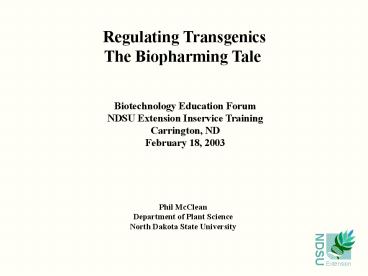Regulating Transgenics - PowerPoint PPT Presentation
1 / 13
Title:
Regulating Transgenics
Description:
Regulating Transgenics The Biopharming Tale Biotechnology Education Forum NDSU Extension Inservice Training Carrington, ND February 18, 2003 Phil McClean – PowerPoint PPT presentation
Number of Views:47
Avg rating:3.0/5.0
Title: Regulating Transgenics
1
Regulating Transgenics The Biopharming Tale
Biotechnology Education Forum NDSU Extension
Inservice Training Carrington, ND February 18,
2003
Phil McClean Department of Plant Science North
Dakota State University
2
What is Biopharming?
Biopharming Definition
Growing transgenic crops that express
pharmaceutical products
Examples
Drugs Antibodies Proteins
3
Why use this technology?
Familiar Production Systems
- Genes introduced into field crops
- New productions systems not needed
- Producer can use traditional growing strategies
Reduced End-Product Cost
- Animal system 1000 - 5000 per gram protein
- Plant System 1 - 10 per gram protein
-
-
Source The Roanoke Times, 2000
4
Value of Biopharaming Industry Estimates
Epicyte Pharmaceutical 200 acres of corn
production equal to production of 400
million plant
ProdiGene One bushel of corn expressing avidin
(important chicken protein) equal to one
ton of egss costing 1000
Source Los Angeles Times June 4, 2002
5
The Road to A Biopharm Product The Regulatory
Process
Regulations Based on Existing (Not New)
Regulations
- Federal Plant Pest Act (FPPA)
- Federal Food, Drug,and Cosmetic Act (FFDCA)
- Federal Insceticide, Fungicide, and Rodenticide
Act (FIFRA) - Toxic Substances Control Act (TSCA)
6
Each Step Is Regulated By A Different Agency
1. Developing the Biopharm Transgenic
Local Institutional Biosafety Committee
- Ensures the genetic engineering experiments are
sage - Field Testing the Transgenic
7
2. Field Testing the Transgenic
USDA APHIS
- Sets standards for field trials
- Approves field trials
- Possibility of escape must be minimized
3. Commercial Production
USDA APHIS
- Proof that transgenic is not an environmental
threat - is presented by company
- Proof reviewed and transgenic declared
- as non-regulated
8
3. Plant is not toxic to environment
EPA
- Approves transgenic with a pesticidal property
(Bt crops) - Sets field toxicity levels
4. Food Safety Concerns
FDA
- Developer provides summary of safety
- and nutritional data
- Data is voluntary but all released products
- have followed this procedure
- Proposed rule summary data is pre-released
- 120 days before product reaches market
9
The Biopharming Bust Story (2002)
Company ProdiGene Product a corn transgenic
expressing a drug that prevents
pig diarrhea Field Test Plants grown in 2001 on
Nebraska and Iowa farms same
fields sown to soybean in 2002 Problem
Volunteers corn transgenics discovered during the
season (IA) and after soybeans
were harvested (NE) Result IA - all field were
burned NE - all the soybeans in the
elevator were confiscated Why ProdiGene did not
follow the field trial regulations Cost Fine -
250,000 (not following regulations)
Restitution - 3 million (contaminated soybeans)
10
The ProdiGene Fallout
- ProdiGene fined 250,00
- ProdiGene promised to cover 2.8 million
- cost of contaminated soybeans
- Company kept its permit to grow field trials,
but - Promised to better follow APHIS regulations
- Test plots will likely be grown outside the corn
belt
11
Other Regulatory Problems
Starlink (Aventis) - 2000
- Biotech industry ensured no contamination was
occurring - Watchdog groups did testing
- BT corn approved for animal consumption found in
- products for human consumption
- Occurred because of mixing
- Aventis removes StarLink line from production
- Company executives lose their jobs
- Product found as late as December 2001 in Japan
12
GT200 Roundup Canola (Monsanto) - 2002
- Monsanto developed two Roundup resistant canola
transgenics - One approved, RT73
- One withdrawn, GT200
- GT200 found in Canada canola
- Why??
- Most likely, cross pollination
- Monsanto response
- Asked USDA for non-regulatory status
13
Lessons Learned
- The regulatory process is important
- It must be followed
- It should be viewed as a cost of business
not a hindrance - The public watching
- Be concerned for their viewpoint
- Mistakes will be made
- Inadvertent or otherwise (StarLink)
- You cant beat biology (GT200)































